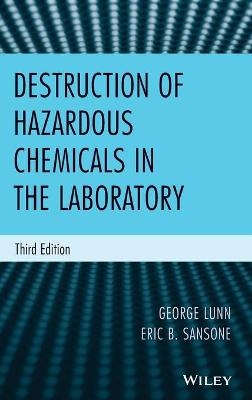
Destruction of Hazardous Chemicals in the Laboratory
Wiley-Blackwell (Verlag)
978-0-470-48755-6 (ISBN)
- Titel erscheint in neuer Auflage
- Artikel merken
The book describes practical procedures for the destruction of hazardous chemicals and biological agents in the laboratory in which they are used. The book is a continuation and expansion of Destruction of Hazardous Chemicals in the Laboratory. It follows the same general approach as the first and second editions but includes a number of new chapters including one on using advanced oxidation techniques as a general means of degrading chemicals. All the monographs from the second edition are incorporated in this volume and are revised and extended as necessary. A number of new monographs describing procedures for the destruction of hazardous chemicals have also been added. The destruction of many pharmaceuticals is also described in this book. This subject has become of increasing importance with recent reports of the detection of pharmaceuticals in the water supply. Finally a new addition is the chapter General Methods for the Destruction of Hazardous Chemicals in the Laboratory. This chapter describes recent advanced oxidation methods that should be generally applicable to all organic compounds. The methods use commonly available laboratory equipment and reagents.
George Lunn, PhD, has been working as a review chemist for the FDA's Office of New Drug Quality Assessment since 1996. Previously, he was a senior research scientist in the Environmental Control and Research Program at the NCI-Frederick Cancer Research and Development Center. He has written nine books and over sixty papers and review articles. Eric B. Sansone, PhD, was the director of the Environmental Control and Research Program at the NCI-Frederick Cancer Research and Development Center until his retirement. He has also worked as a consultant in industrial hygiene and air pollution control for a widely diversified group of industries, law firms, universities, and governmental agencies. He has published many articles on the assessment of risk in cancer research.
PREFACE xi ACKNOWLEDGMENTS xiii INTRODUCTION 1 SPECIFIC METHODS FOR THE DESTRUCTION OF HAZARDOUS CHEMICALS IN THE LABORATORY 17 Acetonitrile 19 Acid Halides and Anhydrides 23 Aflatoxins 29 Alkali and Alkaline Earth Metals 37 Alkali Metal Alkoxides 41 Anatoxin-A 43 Aromatic Amines 47 Arsenic 57 Azides 61 Azo and Azoxy Compounds and Tetrazenes 69 Boron Trifluoride and Inorganic Fluorides 77 Botulinum Toxins 81 Brevetoxins 85 Butyllithium 89 Calcium Carbide 93 Carbamic Acid Esters 95 Carbofuran 99 Chloromethylsilanes and Silicon Tetrachloride 101 N-Chlorosuccinimide and Chloramine-T 103 Chlorosulfonic Acid 105 Chromium(VI) 107 Citrinin 113 Complex Metal Hydrides 121 Cyanides and Cyanogen Bromide 129 Cylindrospermopsin 137 Diisopropyl Fluorophosphate 141 Dimethyl Sulfate and Related Compounds 151 Dyes and Biological Stains 163 Ethidium Bromide 201 Haloethers 211 Halogenated Compounds 217 Halogens 229 Heavy Metals 233 Hexamethylphosphoramide 241 Hydrazines 245 Hypochlorites 257 Mercury 261 2-Methylaziridine 267 1-Methyl-4-phenyl-1,2,3,6-tetrahydropyridine (MPTP) 271 Microcystins 277 4-Nitrobiphenyl 283 3-Nitrofluoranthene and 3-Aminofluoranthene 287 Nitrogen Tetroxide 291 N-Nitroso Compounds: Nitrosamides 293 N-Nitroso Compounds: Nitrosamines 307 Ochratoxin A 319 Organic Nitriles 327 Osmium Tetroxide 331 Palytoxin 335 Patulin 339 Peracids 347 Perchlorates 349 Peroxides and Hydroperoxides 355 Phenol 359 Phosgene 363 Phosphorus and Phosphorus Pentoxide 367 Picric Acid 371 Polycyclic Aromatic Hydrocarbons 375 Polycyclic Heterocyclic Hydrocarbons 387 Potassium Permanganate 405 b-Propiolactone 407 Protease Inhibitors 411 Ricin 417 Saxitoxin 421 Selenium Compounds 425 Sodium Amide 427 Sterigmatocystin 429 Sulfonyl Fluoride Enzyme Inhibitors 437 Sulfur-Containing Compounds 443 T-2 Toxin 449 Tetrodotoxin 455 Triacetone Triperoxide 459 Uranyl Compounds 463 METHODS FOR THE DESTRUCTION OF PHARMACEUTICALS IN THE LABORATORY 467 Pharmaceuticals: General Considerations 469 A: Potassium Permanganate 549 B: Sodium Hypochlorite 567 C: Nickel-Aluminum Alloy Reduction 575 D: Fenton s Reagent 583 E: Photo-Fenton Reaction 587 F: Hydrogen Peroxide 591 G: Hydrogen Peroxide and Horseradish Peroxidase 593 H: Ozone 595 I: Hydroxylamine Degradation of b-Lactams 603 J: Miscellaneous Chemical Degradation Procedures 605 K: Photolytic Degradation Procedures 613 L: Decontamination of Aqueous Solutions 627 NONSPECIFIC METHODS FOR THE DESTRUCTION OF HAZARDOUS CHEMICALS IN THE LABORATORY 631 APPENDIXES 655 APPENDIX I: Procedures for Drying Organic Solvents 657 APPENDIX II: Safety Considerations with Potassium Permanganate 661 MOLECULAR FORMULA INDEX 671 CAS REGISTRY NUMBER INDEX 681 CROSS INDEX OF PHARMACEUTICAL NAMES 693 CROSS-INDEX OF NAMES FOR DYES AND BIOLOGICAL STAINS 729 NAME INDEX 757
| Verlagsort | Hoboken |
|---|---|
| Sprache | englisch |
| Maße | 156 x 234 mm |
| Gewicht | 1220 g |
| Themenwelt | Naturwissenschaften ► Chemie |
| Technik | |
| ISBN-10 | 0-470-48755-0 / 0470487550 |
| ISBN-13 | 978-0-470-48755-6 / 9780470487556 |
| Zustand | Neuware |
| Informationen gemäß Produktsicherheitsverordnung (GPSR) | |
| Haben Sie eine Frage zum Produkt? |
aus dem Bereich



